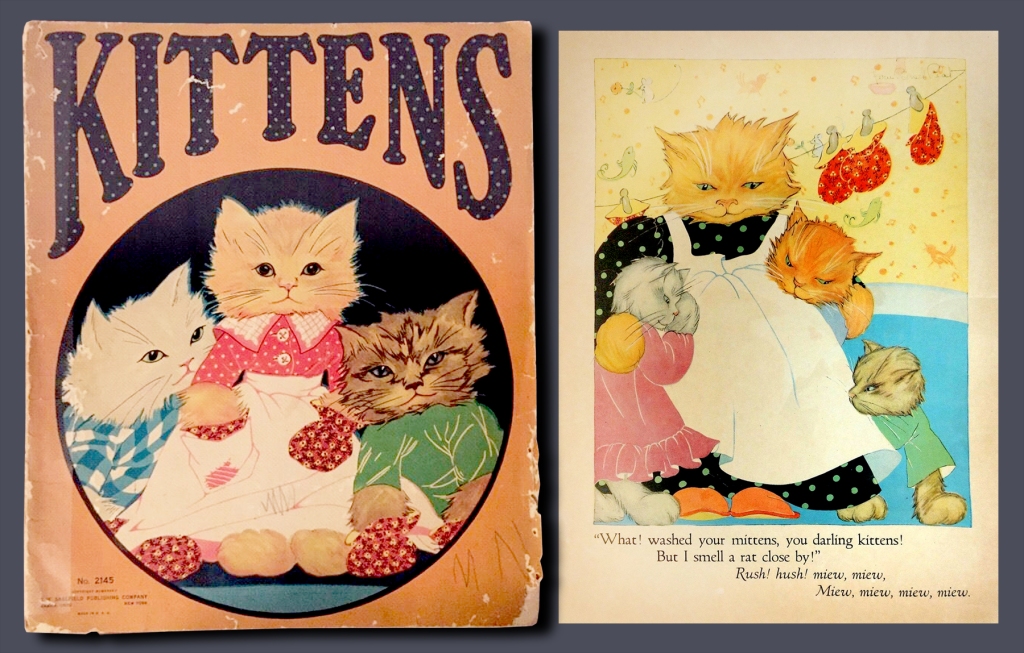
Some of the most classic and highly sought-after children’s art from the 1930s American Art Deco movement was created in Richland County.
Fern Bisel Peat was a storyteller for generations of children in America. Her distinctive pastel paintings illustrated hundreds of books and magazines, and decorated dozens of favorite early childhood playthings. Most of her work was created a few miles west of Bellville at her farm called Beech Hollow.
This little exhibit shows why kids in the decades from the 1920s to the 50s recognized Fern as one of their closest friends.

Every child recognizes their closest friends as soon as they see them: they are warm and round, often enough furry or made of soft cloth; they have kind eyes and make you smile inside. This pretty much describes all the characters Fern designed.
Many were animals; quite a few depicted classic roles from traditional tales. All of these lovable characters shaped the hearts of children who looked for them in books, on the walls, on their toys.

Behind The Drawing Board
Fern Bisel was born in 1893 in Erie PA, and went to public schools in Elyria. She attended Ohio Wesleyan University in Delaware, graduating with a degree in fine arts.
She married Frank Peat in 1917 before he went off to serve in the armed forces during WW I, and after the war the Peats and their growing family settled in northern Ohio. In the 1920s Fern began painting children’s murals in public and private sites.
Her work became so popular that she was asked to design wallpaper for a Cleveland firm, and she made a set of Mother Goose wall panels that sold widely.
While Fern was doing a mural in Akron, an editor from the Saalfield Publishing Co. introduced herself and asked Fern if she had done any book illustration. That was the beginning of the Saalfield years of Fern’s career.
Her first book, Mother Goose, was created from a set of reading cards that Fern had designed to teach her first-grade son how to recognize letters.
From there she went on to illustrate over 60 books.
From 1933 to 1955 she was editor and chief illustrator for Children’s Play Mate magazine, published in Cleveland.

In 1933 the Peats moved to the Bisel family homestead on Woodberry Road near Bellville, and it was from there, at Beech Hollow Farm, that most of her work originated.
Mrs. Peat created storybook worlds for children, so it seemed appropriate that she also should have created a storybook cottage on her family’s homestead in southern Richland County. The Peat’s house had shutters that were painted in bright colors with fantasy characters from her children’s books.
The second floor of the house was her painting studio, and other artists and designers shared space with her in the home and in the surrounding outbuildings. It came to be known in its day as Richland County’s ‘Art Colony.’

It was from Beech Hollow that the Play Mate magazines originated for 20 years. Frank did the layout work, and he was nominally referred to as the magazine’s Managing Editor—primarily because it was he who had the job of racing to Galion to catch the train in order to deliver the art to Cleveland by deadline.
A Vast Body Of Work
Collectors who search for Fern’s work can easily spend a lifetime discovering all the many different variations.
As breadwinner for the Bisel Peat family, Fern found every way possible to market her work to publishers, advertising firms and toy makers during the lean years of the American Depression and World War II. Consequently, you can find her distinctive illustrations in any number of publications from those years.
Her most popular books came out in many editions, and each new printing had a new cover.
The stylish children’s illustrations can be found on everything from holiday decorations, paper fans and playing cards to rag dolls and tin toys…not to mention coloring books, paper doll books, and greeting cards.
The Ohio Art Company of Bryan, Ohio, produced her designs on toys of all description including no fewer than 7 tea sets, 5 watering cans, 17 buckets and sand pails of all sizes, 3 drums, 9 tops, 4 miniature tea sets, banks, washing tubs & washboards, and snow shovels.
Her easily recognizable style can be found on furniture as well, from a New York firm that manufactured toy chests and room dividers for nurseries in the 1930s.











At The End Of The Storybook
Fern’s son was killed in WWII and the shock seemed to trigger a decline in her health. Through years of slowly growing confusion she developed what we would recognize today as Alzheimer’s Syndrome, and she spent the last years of her life in Florida being cared for by her husband Frank.
Fern Bisel Peat died in 1971 and is buried in Shauck Cemetery near Johnsville.
